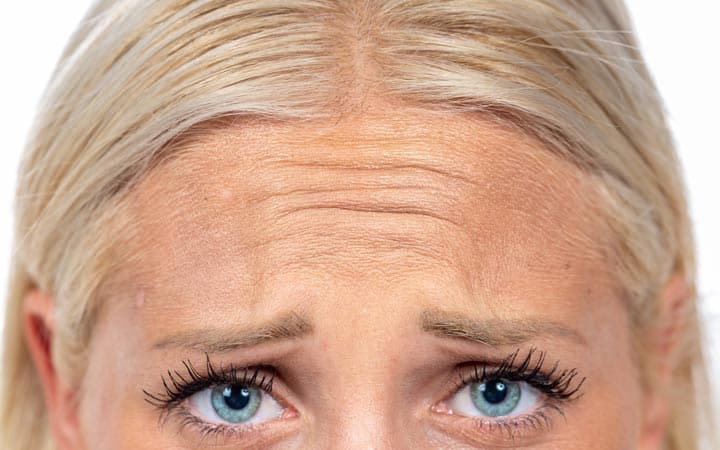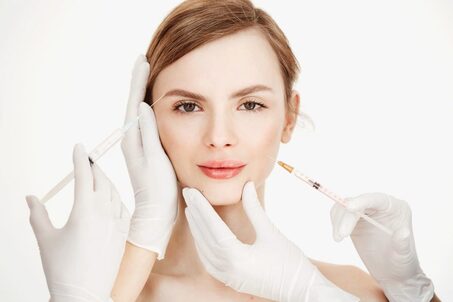Reviewed by Prof. Fuat Yuksel.
If you’ve been thinking of getting rid of the wrinkles and fine lines on your face, chances are you would’ve heard about Botox.
However, there’s another neuromodulator whose name pops up along with it: Dysport. That leads to the “Dysport vs Botox” comparisons to determine how they differ and which one is better for treating particular aesthetic issues.
Both Dysport and Botox are neuromodulators, and they work the same way:
Block the signal of the nerves to the muscles to prevent their contraction. Since the muscle isn’t used, it starts to atrophy (although it’s temporary).
However, the manufacturers and trade names of these two are different.
- Botox® (OnabotulinumtoxinA/OBA) is a product of Allergan
- Dysport® (AbobotulinumtoxinA/ABO) is a product of Galderma
That’s not the only difference in the Dysport vs Botox debate, though. Before we get into that, let’s find out their similarities.
What is Dysport vs Botox?
Both are injectables containing toxins made from the bacterium Clostridium botulinum. These are safe, non-surgical treatments that aim to treat wrinkles and fine lines across different areas of the face.
They’re also approved by the Food and Drug Administration (FDA); Botox got the approval in 2002, while Dysport got it in 2009. However, the exact areas for which Dysport and Botox have approval for treating wrinkles and fine lines is different.
Both these treatments are considered lunchtime cosmetic procedures since they only take a few minutes, and there’s no downtime or recovery period.
Lastly, both of them only give temporary results, although there’s a difference in the duration for which the results take effect and last. With both of them, you’d need follow-up injections for the maintenance of the results.

Dysport vs Botox: What Are the Differences?
Let’s take a look at the differences between the two cosmetic procedures.
Formulation
At their core, both Dysport vs Botox is made of botulinum toxin A. The difference is in the protein molecule that’s attached to these.
Overall, the molecular weight of Dysport is lesser than Botox, which means that it is less “weighed down” than Botox. This helps with the spread of the formulation in the injected area.
Of course, trained practitioners should know and understand that this is how Dysport works. That’s because used in the wrong area, the diffusion of Dysport can cause droopiness.
Treatment Areas (Approved by the FDA)
That’s where Dysport vs Botox differ again.
Dysport is approved by the FDA for the treatment of moderate or severe glabellar lines/frown lines. These are the vertical lines, also known as “11’s”, that are present between the eyebrows and extend into the forehead.
Despite that, it is administered in different areas of the face. Since it is diffusible, it’s better for larger areas like the forehead.
Botox, on the other hand, has FDA approval for moderate to severe forehead lines, crow’s feet (wrinkles around the eyes) and glabellar lines.
Here, you should keep in mind that both Botox and Dysport are for moderate to severe wrinkles or fine lines. What’s considered “moderate” or “severe” should be informed to you by your dermatologist.
If you have a more “mild” concern, then your derm may recommend other treatment options like eyebrow lift, facelift…etc.
Cost
Dysport vs Botox price has been much asked about.
Both of these treatments have varying prices based on the size and number of treatment areas and the number of injectable units required.
However, usually, Dysport is less expensive than Botox, but the price can vary depending on where you live, the medical practitioner you choose, and the location of his/her clinic.
Dose Conversion Ratio
In the Dysport vs Botox debate, the dosage is also different.
You need more units of Dysport than Botox to achieve the same effect. There has been much research on the conversion factor of the two injectables.
According to DermNet NZ, it is 1:2.5 to 1:5. If we take the former ratio, you need 25 units of Dysport to have the same effect as 10 units of Botox. If we take the latter ratio, you need 50 units of Dysport for 10 units of Botox.
Some people also ask, “100 units of Dysport equals how much Botox?” If we take the conversion factors above, for the first one, it’ll be 100 units of Dysport equals 40 units of Botox, and for the second one, 100 units of Dysport equal 50 units of Botox. They’re not of equal strength.
Recommended Treatment Dosage
According to the FDA, the recommended dosage of Dysport for glabellar lines is 50 units divided into 5 portions.
For Botox, the FDA recommended dosage depends on the area being treated. It is as follows:
- Glabellar lines: 4 units into 5 injection sites, so 20 units in total.
- Crow’s feet: 4 units into 6 injection sites (3 per eye), so 24 units in total.
- Forehead lines: 4 units for the 5 injection sites. so 20 units in total.
If you’re getting Botox for all these types of wrinkles, you’ll need 64 units of Botox. The FDA also recommends that you should not get more than 400 units of Botox in a duration of 3 months.
While for Dysport (for glabellar lines), you need to wait for 3 months before getting the next treatment.
Appearance of Results
There’s a difference between Dysport vs Botox in how quickly the results take effect.
The results of Dysport appear in 2-3 days, while Botox takes effect in a week.
So, if you’re looking for a quicker solution to your wrinkles and fine lines, Dysport may be the better option (but it depends on the area where you’re getting the injection).
Longevity of Results
Although the results from Dysport may appear quicker, they might not last as long as Botox.
While the results from Botox usually last anywhere between 3-6 months, Dysport lasts for about 4 months.
However, there isn’t a cookie-cutter answer to this. That’s because how long the results last depends on a few factors, such as:
- Metabolism: Higher metabolism, as is the case with athletes, will metabolize the Botox more quickly.
- Size of the muscle/injection site: The effect wears off more quickly in larger muscles like in the forehead.
- Frequency of treatment: The more you’ve been getting it, the longer it will last.
- Dosage: The amount of Botox used will also affect the longevity of the results. It will wear off more quickly if the dose is less.
Therefore, you shouldn’t always compare your case with that of other people as there are a lot of individual differences.
Adverse Reactions
Dysport vs Botox can cause different adverse reactions.
With Botox, the FDA warns of:
- Droopiness of the eyelids if you’re getting Botox for the glabellar lines (rare, according to the American Academy of Dermatology)
- Swelling of the eyelids if you’re getting it for your crow’s feet
- Headache (not that common) and drooping eyebrows (rare) if you’re getting it for your forehead lines
It is also common to experience pain, redness, and soreness at the site of the injection.
In case of Dysport for the frown lines, the FDA warns of:
- Pain at the site of the injection
- Headache
- Infection of the upper respiratory tract
- Swelling of the eyelids
- Drooping eyelids
- Nausea
- Blood in urine
- Cold (Nasopharyngitis)
- Sinus infection
- Reaction at the site of the injection
Discuss these with your doctor before getting the treatment.
Comparison Summary
Dysport vs Botox is similar and different in many ways. You can check the summary below.
| Dysport | Botox | |
| Procedure | Non-surgical
Injection in a few sites (takes a few minutes) | Non-surgical
Injection in a few sites (takes a few minutes) |
| Cost | Less expensive | More expensive |
| Treatment Areas | Glabellar/frown lines | Crow’s feet, forehead lines, and frown lines |
| Effect of Treatment | 2-3 days | 1 week |
| Longevity of Results | 4 months (temporary) | 3-6 months (temporary) |
| Dosage | 50 units for frown lines | Varies according to treatment area |
| Downtime | None | None |
Is Dysport More Effective than Botox?
There’s no clear answer to that. So far, there doesn’t seem to be much of a difference. A lot of the studies that are available on them have been funded by the manufacturers of these injectables.
In 2011, a randomized, double-blind study was published in The Journal of Clinical and Aesthetic Dermatology.
It showed that the results of Dysport lasted longer than Botox when used at a conversion ratio of 1:2.5. It was company-funded, so the results aren’t as reliable.
In 2018, another study published in Toxins concluded that because of the presence of a greater amount of neurotoxin in Dysport (at the FDA recommended dosages), it was able to block the stimulation of muscles by nerves for longer, which is why its results lasted for longer. Again, the study was company funded.
However, some studies show that there is no difference between the effectiveness of the two in some areas of the face, while in other one performs better than the other.
Which Treatment Should You Get?
Your dermatologist can best advise you about this. This may come down to the treatment area and your unique anatomy. There are some people for whom one type of injectable isn’t working, so they switch to another one.
To get a better understanding of the kind of results that you can get from these treatments, you should ask for the before/after photos of the patients.
Final Takeaways
There are pros and cons of Dysport vs Botox. In many cases, they’re the same. However, they do have some differences that can make a difference in the final result.
You should understand these and consult your dermatologist about the treatment that will best suit your particular needs.

